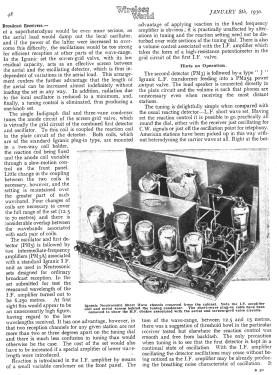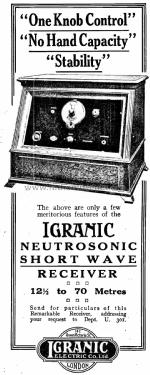Neutrosonic Short Wave
Igranic Electric Co. Ltd.; Bedford
- Country
- Great Britain (UK)
- Manufacturer / Brand
- Igranic Electric Co. Ltd.; Bedford
- Year
- 1929
- Category
- Broadcast Receiver - or past WW2 Tuner
- Radiomuseum.org ID
- 182876
Click on the schematic thumbnail to request the schematic as a free document.
- Number of Tubes
- 6
- Main principle
- Superhet, IF regeneration; ZF/IF 48 kHz; Screengrid 1926-1935
- Wave bands
- Short Wave (SW only)
- Power type and voltage
- Storage and/or dry batteries
- Loudspeaker
- - This model requires external speaker(s).
- Material
- Wooden case
- from Radiomuseum.org
- Model: Neutrosonic Short Wave - Igranic Electric Co. Ltd.;
- Shape
- Tablemodel, slant panel.
- Notes
-
The Superheterodyne Principle to Shortwave Reception was described in Wireless World in January 1930.
The article discusses a new radio receiver from Igranic that uses the superheterodyne principle to receive shortwave signals effectively.
Key points:
- The superheterodyne principle is used to convert the incoming frequency to a lower value for easier amplification, particularly for frequencies below 100 metres.
- Igranic's set demonstrates good control over these high frequencies, functioning down to 15 metres.
- The set uses an aperiodic aerial circuit, avoiding the problems of harmonics and blind spots encountered with tuned circuits.
- A screen-grid valve acts as a buffer between the aerial and oscillator, improving stability and allowing for longer aerials.
- The set features a single tuning dial and a slow-motion control for reaction, simplifying operation.
- Four sets of coils cover the entire range (12.5 to 70 metres) with overlapping bands for finer tuning.
- The intermediate-frequency amplifier operates at a higher wavelength (6,250 metres) for easier tuning and to avoid confusion with other stations.
- Reaction is introduced in the I.F. amplifier, providing stable control and minimizing adjustments.
- The set delivers strong audio output, eliminating the need for headphones.
- Overall, the Igranic radio receiver appears to be a well-designed and effective solution for shortwave reception, offering advantages in stability, ease of use, and performance.
The price in oak, including valves, coils and royalties, but excluding batteries and loudspeaker, is £28.
- Price in first year of sale
- 28.00 GBP
- Literature/Schematics (1)
- Wireless World (The), London (WW, 79) (JAN 8, 1930)
- Author
- Model page created by Roy Johnson. See "Data change" for further contributors.
- Other Models
-
Here you find 36 models, 34 with images and 2 with schematics for wireless sets etc. In French: TSF for Télégraphie sans fil.
All listed radios etc. from Igranic Electric Co. Ltd.; Bedford






